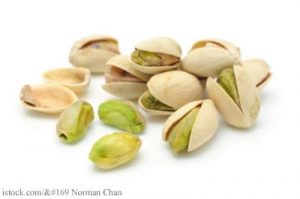The current Salmonella outbreak linked to recalled Wonderful pistachios brings up a question: how does Salmonella get on pistachios? Most of us are familiar with problems with Salmonella on poultry and in eggs. But a dry, shelf-stable product such as pistachios doesn’t seem to be a candidate for this bacteria.
 Unfortunately, Salmonella can live for a long time on dry products, according to research published in the Journal of Food Protection in October 2015. Salmonella can survive for at least six months on foods that are very dry, and will not grow, but survive, on foods that are refrigerated or frozen. And, as we have told you before, any product, including produce, which includes nuts, can be contaminated with bacteria.
Unfortunately, Salmonella can live for a long time on dry products, according to research published in the Journal of Food Protection in October 2015. Salmonella can survive for at least six months on foods that are very dry, and will not grow, but survive, on foods that are refrigerated or frozen. And, as we have told you before, any product, including produce, which includes nuts, can be contaminated with bacteria.
There have been 89 recalls of nut butters and nuts for pathogenic bacterial contamination since 2001 in the United States, 25 just in 2015. Most of those recalls have occurred since 2012. And there have been 12 outbreaks linked to nut and nut butter products since 2001, sickening at least 1,275 people in this country. The nuts can be contaminated while they are still on the trees, from bird poop or contaminated irrigation water, or contaminated during harvest. Dirty transportation containers or problems in processing facilities can also cause contamination with pathogenic bacteria.
There has been an ongoing debate about the safety of raw nuts versus roasted or heat-treated nuts. Many people believe that, once heated, nuts lose some of their nutritional quality, including fats, enzymes, and beneficial bacteria. Almonds are a particular hot spot, especially since 2007, when the FDA ordered that all out-of-shell almonds sold in this country be “pasteurized” before sale, because they have been linked to so many food poisoning outbreaks.
But even nuts that are heat treated can become contaminated with pathogenic bacteria. Problems in facilities and in transport can contaminate any product at any time in the food processing chain.
In the current outbreak, eleven people in nine states have been sickened with the outbreak strain of Salmonella Montevideo. The case count by state is: Alabama (1), Arizona (1), Connecticut (1), Georgia (1), Michigan (1), Minnesota (1), North Dakota (1), Virginia (1), and Washington state (2). Two people have been hospitalized because their illnesses are so severe. Illnesses started on dates ranging from December 12, 2015 to February 9, 2016. Ill persons range in age from 9 years to 69, and 73% of ill persons are male.
Investigation of the outbreak indicates that pistachios produced by Wonderful Pistachios of Lost Hills, California are a likely source of this outbreak. Of the nine sick people interviewed, eight, or 89%, ate pistachios the week before they got sick. And five of the eight, or 63%, said they ate Wonderful brand pistachios. And laboratory testing isolated the outbreak strain of Salmonella Montevideo from samples of raw pistachios collected from Paramount Farms, where Wonderful pistachios are grown.
There have been several recalls of pistachios since the outbreak was announced. The nuts were sold nationwide in the U.S., in Canada, Mexico, and Peru. The recalls for for Nature’s Eats natural pistachios kernels, Favorites pistachios, and Wonderful, Trader Joe’s, and Paramount Farms in shell and shelled pistachios.
The symptoms of a Salmonella infection include nausea, vomiting, abdominal pain, diarrhea, fever, chills, headache, muscle pains, and blood in the stool. Symptoms usually begin six to seventy-two hours after exposure to the bacteria. Most people get better in about a week, but some become so ill they must be hospitalized. If you ate any of the recalled pistachios and have experienced these symptoms, please see your doctor.




